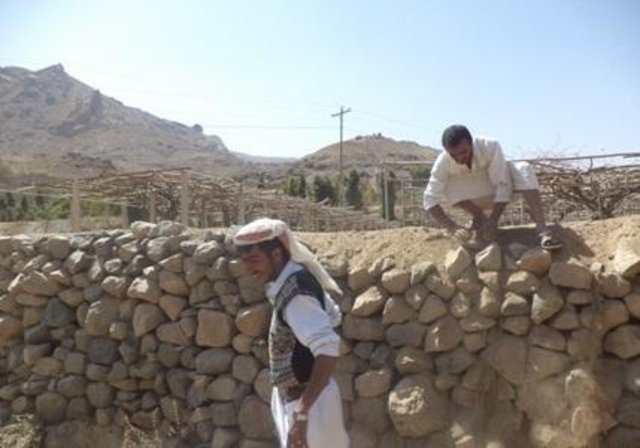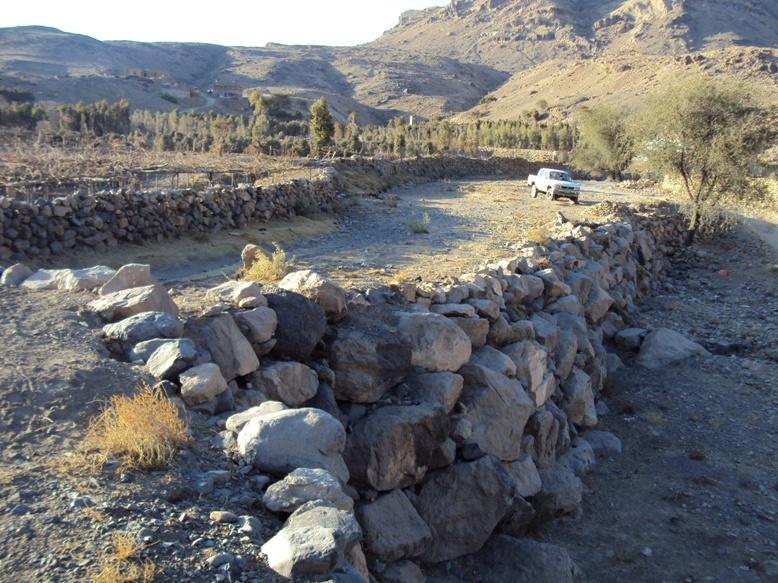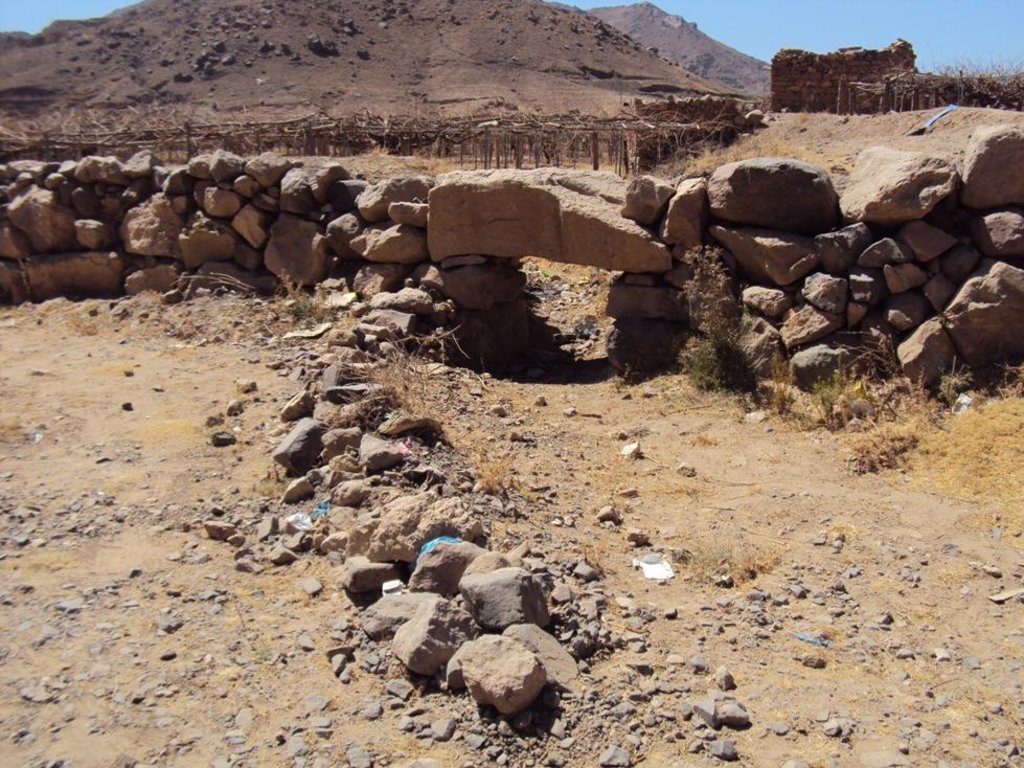Diversion construction with gates and distribution channels [เยเมน]
- ผู้สร้างสรรค์:
- การอัพเดท:
- ผู้รวบรวม: ahmed algalal
- ผู้เรียบเรียง: –
- ผู้ตรวจสอบ: David Streiff, Alexandra Gavilano
الحواجز (الرزم) والبوابات والسواقي
technologies_1562 - เยเมน
- บทสรุปทั้งหมดในรูปแบบของ PDF
- บทสรุปทั้งหมดในรูปแบบของ PDF เพื่อพิมพ์
- บทสรุปทั้งหมดในรูปหน้าเว็บ
- บทสรุปทั้งหมด (ไม่มีการจัดเรียง)
- Diversion construction with gates and distribution channels: 24 มิถุนายน 2017 (inactive)
- Diversion construction with gates and distribution channels: 24 มิถุนายน 2017 (inactive)
- Diversion construction with gates and distribution channels: 13 สิงหาคม 2019 (inactive)
- Diversion construction with gates and distribution channels: 25 พฤศจิกายน 2022 (public)
ดูส่วนย่อย
ขยายทั้งหมด ย่อทั้งหมด1. ข้อมูลทั่วไป
1.2 รายละเอียดที่ติดต่อได้ของผู้รวบรวมและองค์กรที่เกี่ยวข้องในการประเมินและการจัดเตรียมทำเอกสารของเทคโนโลยี
ผู้เชี่ยวชาญ SLM:
AL Hadrami Yahya
General Directorate of Irrigation
เยเมน
ผู้เชี่ยวชาญ SLM:
Sallam Ahmed
Agricultural Research and Extension Authority
เยเมน
ชื่อขององค์กรซึ่งอำนวยความสะดวกในการทำเอกสารหรือการประเมินเทคโนโลยี (ถ้าเกี่ยวข้อง)
Agricultural Research and Extension Authority (AREA) - เยเมนชื่อขององค์กรซึ่งอำนวยความสะดวกในการทำเอกสารหรือการประเมินเทคโนโลยี (ถ้าเกี่ยวข้อง)
General Directorate of Irrigation - เยเมน1.3 เงื่อนไขการใช้ข้อมูลที่ได้บันทึกผ่านทาง WOCAT
ผู้รวบรวมและวิทยากรหลักยอมรับเงื่อนไขเกี่ยวกับการใช้ข้อมูลที่ถูกบันทึกผ่านทาง WOCAT:
ใช่
1.5 Reference to Questionnaire(s) on SLM Approaches (documented using WOCAT)

Rehabilitation of terraces and diversion construction with gates … [เยเมน]
The rehabilitation of walls and outlets of the terraces and diversion construction with accessories from channels and gates are carried out by the local community in a regular way
- ผู้รวบรวม: ahmed algalal
2. การอธิบายลักษณะของเทคโนโลยี SLM
2.1 การอธิบายแบบสั้น ๆ ของเทคโนโลยี
คำจำกัดความของเทคโนโลยี:
The stone existed in the region are used for building diversion constructions to raise the level of wadi bed to the level of the inlet of the cultivated land that need to be irrigated from water harvesting in addition to distribution channels in the fields
2.2 การอธิบายแบบละเอียดของเทคโนโลยี
คำอธิบาย:
Diversion construction (DC) technology is one the structural solutions using stones with slope and tan 30 to slow the water flow and to deposits the carried materials with water to allow water to pass throw the inlet (gate) to the fields that need to be irrigated without damaged mainly vines and qat crops. The site of DC must be built in direction of water flow to direct it to pass to the fields need to be irrigated to get a benefit from this water harvested the height of the DC should be equalled to the height of the cultivated land which ranges between 2-4 meter and the width is 1.5 meter and the length is ranged between 40-60 meter based on the width of wadi bed. The DC should not built totally in one time but should be gradually and by the time as a result of deposit be come at the same level of fields need to irrigated. Finally when the height of DC become equally to level of the field need to irrigated the gate should be determined according to water requirement of cultivated crops. After that distribution channels should built at 1-2 wide, 0.5- 0.8 height and 10-100 length. Such as this type of technology is considered a long term process in the past due to lack of equipments and implements. However now it can be done in short time if all requirement provided especially funds and equipments.
2.3 รูปภาพของเทคโนโลยี
2.5 ประเทศภูมิภาค หรือสถานที่ตั้งที่เทคโนโลยีได้นำไปใช้และได้รับการครอบคลุมโดยการประเมินนี้
ประเทศ:
เยเมน
ภูมิภาค/รัฐ/จังหวัด:
Sana
ข้อมูลจำเพาะเพิ่มเติมของสถานที่ตั้ง :
Bani Hushaish district
แสดงความคิดเห็น:
Total area covered by the SLM Technology is 20.6 km2.
Alrawanah Bani Hushaish, which is located on the eastern side of the capital Sanaa, and is about 16 km away
Map
×2.6 วันที่การดำเนินการ
ถ้าไม่รู้ปีที่แน่นอน ให้ระบุวันที่โดยประมาณ:
- มากกว่า 50 ปี (แบบดั้งเดิม)
2.7 คำแนะนำของเทคโนโลยี
ให้ระบุว่าเทคโนโลยีถูกแนะนำเข้ามาอย่างไร:
- เป็นส่วนหนึ่งของระบบแบบดั้งเดิมที่ทำก้นอยู่ (> 50 ปี)
ความคิดเห็น (ประเภทของโครงการ เป็นต้น) :
It is a very ancient technology but was rehabilitated in 1956 by the community
3. การจัดประเภทของเทคโนโลยี SLM
3.1 วัตถุประสงค์หลักของเทคโนโลยี
- ลด ป้องกัน ฟื้นฟู การเสื่อมโทรมของที่ดิน
3.2 ประเภทของการใช้ที่ดินในปัจจุบันที่ได้นำเทคโนโลยีไปใช้

พื้นที่ปลูกพืช
- การปลูกไม้ยืนต้น ไม้พุ่ม
Tree and shrub cropping - Specify crops:
- grapes
- Qat
จำนวนของฤดูเพาะปลูกต่อปี:
- 1
ระบุ:
Longest growing period in days: 90
แสดงความคิดเห็น:
Major land use problems (compiler’s opinion): Low productivity due to a lack of water (drought)
Major land use problems (land users’ perception): drought
Future (final) land use (after implementation of SLM Technology): Cropland: Ct: Tree and shrub cropping
3.3 Has land use changed due to the implementation of the Technology?

พื้นที่ปลูกพืช
- การปลูกไม้ยืนต้น ไม้พุ่ม
แสดงความคิดเห็น:
Future (final) land use (after implementation of SLM Technology): Cropland: Ct: Tree and shrub cropping
3.4 การใช้น้ำ
การใช้น้ำของที่ดินที่มีการใช้เทคโนโลยีอยู่:
- จากน้ำฝน
แสดงความคิดเห็น:
Water supply: Also mixed rainfed - irrigated and post-flooding
3.5 กลุ่ม SLM ที่ตรงกับเทคโนโลยีนี้
- มาตรการปลูกพืชขวางความลาดชัน (cross-slope measure)
- การผันน้ำและการระบายน้ำ
3.6 มาตรการ SLM ที่ประกอบกันเป็นเทคโนโลยี

มาตรการอนุรักษ์ด้วยโครงสร้าง
- S11: อื่น ๆ
แสดงความคิดเห็น:
Specification of other structural measures: Diversion construction with gates and distribution channels
3.7 รูปแบบหลักของการเสื่อมโทรมของที่ดินที่ได้รับการแก้ไขโดยเทคโนโลยี

การเสื่อมโทรมของดินทางด้านเคมี
- Cn (Fertility decline): ความอุดมสมบูรณ์และปริมาณอินทรียวัตถุในดินถูกทำให้ลดลงไป (ไม่ได้เกิดจากสาเหตุการกัดกร่อน)

การเสื่อมโทรมของน้ำ
- Ha (Aridification): การเกิดความแห้งแล้ง
แสดงความคิดเห็น:
Secondary types of degradation addressed: Cn: fertility decline and reduced organic matter content
Main causes of degradation: floods, droughts, poverty / wealth (poverty)
Secondary causes of degradation: crop management (annual, perennial, tree/shrub) (up takes of major elements of fertility without subsistent)
3.8 การป้องกัน การลดลง หรือการฟื้นฟูความเสื่อมโทรมของที่ดิน
ระบุเป้าหมายของเทคโนโลยีกับความเสื่อมโทรมของที่ดิน:
- ลดความเสื่อมโทรมของดิน
- ฟื้นฟูบำบัดที่ดินที่เสื่อมโทรมลงอย่างมาก
แสดงความคิดเห็น:
Secondary goals: mitigation / reduction of land degradation
4. ข้อมูลจำเพาะด้านเทคนิค กิจกรรมการนำไปปฏิบัติใช้ ปัจจัยนำเข้า และค่าใช้จ่าย
4.1 แบบแปลนทางเทคนิคของเทคโนโลยี
ข้อมูลจำเพาะด้านเทคนิค (แบบแปลนทางเทคนิคของเทคโนโลยี):
Barrier cuts waterway with gates and distribution channels
Location: Alrawanah Uzlat. Bani Hushaish district
Technical knowledge required for field staff / advisors: high (Construction process requires skills and experiences)
Technical knowledge required for land users: low (Has sufficient expertise)
Main technical functions: water harvesting / increase water supply, water spreading
Secondary technical functions: increase in nutrient availability (supply, recycling,…), increase of groundwater level / recharge of groundwater, Reduce runoff
Structural measure: Diversion construction
Height of bunds/banks/others (m): 2 - 4
Width of bunds/banks/others (m): 1– 1.5
Structural measure: Gates
Height of bunds/banks/others (m): 0.5 -1
Width of bunds/banks/others (m): 0.7–1.2
Structural measure: Channels
Height of bunds/banks/others (m): 0.5–0.8
Width of bunds/banks/others (m): 1 - 2
Length of bunds/banks/others (m): 10-100
Construction material (stone): The diversion construction and the gates are constructed by stones existing in the region
Slope (which determines the spacing indicated above): 5%
ผู้เขียน:
AL-Galal
4.2 ข้อมูลทั่วไปเกี่ยวกับการคำนวณปัจจัยนำเข้าและค่าใช้จ่าย
ระบุสกุลเงินที่ใช้คำนวณค่าใช้จ่าย:
- USD
ระบุค่าเฉลี่ยของค่าจ้างในการจ้างแรงงานต่อวัน:
7.00
4.3 กิจกรรมเพื่อการจัดตั้ง
| กิจกรรม | Timing (season) | |
|---|---|---|
| 1. | Collecting stones and building barriers with gates | Before the rainy season |
| 2. | Building channels | Before the rainy season |
4.4 ค่าใช้จ่ายของปัจจัยนำเข้าที่จำเป็นสำหรับการจัดตั้ง
| ปัจจัยนำเข้า | หน่วย | ปริมาณ | ค่าใช้จ่ายต่อหน่วย | ค่าใช้จ่ายทั้งหมดต่อปัจจัยนำเข้า | %ของค่าใช้จ่ายที่ก่อให้เกิดขึ้นโดยผู้ใช้ที่ดิน | |
|---|---|---|---|---|---|---|
| แรงงาน | Collecting stones and building barriers with gates | persons/day/barrier | 225.0 | 7.0 | 1575.0 | 100.0 |
| แรงงาน | Building channels | persons/day/barrier | 7.0 | 7.0 | 49.0 | 100.0 |
| อุปกรณ์ | Animal traction | barrier | 1.0 | 46.5 | 46.5 | 100.0 |
| อุปกรณ์ | Tools | barrier | 1.0 | 46.5 | 46.5 | 100.0 |
| อุปกรณ์ | Animal traction for channel building | barrier | 1.0 | 16.3 | 16.3 | 100.0 |
| ค่าใช้จ่ายทั้งหมดของการจัดตั้งเทคโนโลยี | 1733.3 | |||||
| Total costs for establishment of the Technology in USD | 1733.3 | |||||
แสดงความคิดเห็น:
Duration of establishment phase: 3 month(s)
4.5 การบำรุงรักษาสภาพหรือกิจกรรมที่เกิดขึ้นเป็นประจำ
| กิจกรรม | ช่วงระยะเวลา/ความถี่ | |
|---|---|---|
| 1. | Repair diversion construction and gates | annually after the rainy season |
| 2. | Clean channels | annually after the rainy season |
4.6 ค่าใช้จ่ายของปัจจัยนำเข้าและกิจกรรมที่เกิดขึ้นเป็นประจำที่ต้องการการบำรุงรักษา (ต่อปี)
| ปัจจัยนำเข้า | หน่วย | ปริมาณ | ค่าใช้จ่ายต่อหน่วย | ค่าใช้จ่ายทั้งหมดต่อปัจจัยนำเข้า | %ของค่าใช้จ่ายที่ก่อให้เกิดขึ้นโดยผู้ใช้ที่ดิน | |
|---|---|---|---|---|---|---|
| แรงงาน | Repair diversion construction and gates | persons/day/unit | 13.0 | 7.0 | 91.0 | 100.0 |
| แรงงาน | Clean channels | persons/day/unit | 2.0 | 7.0 | 14.0 | 100.0 |
| ค่าใช้จ่ายทั้งหมดของการบำรุงรักษาสภาพเทคโนโลยี | 105.0 | |||||
| Total costs for maintenance of the Technology in USD | 105.0 | |||||
แสดงความคิดเห็น:
Machinery/ tools: big hammers, shovel, soil leveller
Costs were calculated according to the current situation, for the barrier with a gate length of 60 meters and a height of 2 meters, and for the channels with an average length of 50 meters and a width of 1 meter.
With regard to maintenance has been developed a lump sum annually where maintenance was done at the current time using modern equipment and as a result of no collapse charges barriers and accessories in most years has been estimated annual sum for the purpose of maintenance in the event of any damage
4.7 ปัจจัยสำคัญที่สุดที่มีผลกระทบต่อค่าใช้จ่าย
ปัจจัยสำคัญที่สุดที่มีผลกระทบต่อค่าใช้จ่ายต่างๆ:
- Transportation and gradient
- difficult roads
- cutting stones
5. สิ่งแวดล้อมทางธรรมชาติและของมนุษย์
5.1 ภูมิอากาศ
ฝนประจำปี
- < 250 ม.ม.
- 251-500 ม.ม.
- 501-750 ม.ม.
- 751-1,000 ม.ม.
- 1,001-1,500 ม.ม.
- 1,501-2,000 ม.ม.
- 2,001-3,000 ม.ม.
- 3,001-4,000 ม.ม.
- > 4,000 ม.ม.
เขตภูมิอากาศเกษตร
- กึ่งแห้งแล้ง
Thermal climate class: temperate
5.2 สภาพภูมิประเทศ
ค่าเฉลี่ยความลาดชัน:
- ราบเรียบ (0-2%)
- ลาดที่ไม่ชัน (3-5%)
- ปานกลาง (6-10%)
- เป็นลูกคลื่น (11-15%)
- เป็นเนิน (16-30%)
- ชัน (31-60%)
- ชันมาก (>60%)
ธรณีสัณฐาน:
- ที่ราบสูง/ที่ราบ
- สันเขา
- ไหล่เขา
- ไหล่เนินเขา
- ตีนเนิน
- หุบเขา
ระดับความสูง:
- 0-100 เมตร
- 101-500 เมตร
- 501-1,000 เมตร
- 1,001-1,500 เมตร
- 1,501-2,000 เมตร
- 2,001-2,500 เมตร
- 2,501-3,000 เมตร
- 3,001-4,000 เมตร
- > 4,000 เมตร
ความคิดเห็นและข้อมูลจำเพาะเพิ่มเติมเรื่องสภาพภูมิประเทศ:
Altitudinal zone: 2400 m a.s.l.
5.3 ดิน
ค่าเฉลี่ยความลึกของดิน:
- ตื้นมาก (0-20 ซ.ม.)
- ตื้น (21-50 ซ.ม.)
- ลึกปานกลาง (51-80 ซ.ม.)
- ลึก (81-120 ซ.ม.)
- ลึกมาก (>120 ซ.ม.)
เนื้อดิน (ดินชั้นบน):
- ปานกลาง (ดินร่วน ทรายแป้ง)
- ละเอียด/หนัก (ดินเหนียว)
อินทรียวัตถุในดิน:
- ปานกลาง (1-3%)
(ถ้ามี) ให้แนบคำอธิบายเรื่องดินแบบเต็มหรือระบุข้อมูลที่มีอยู่ เช่น ชนิดของดิน ค่า pH ของดินหรือความเป็นกรดของดิน ความสามารถในการแลกเปลี่ยนประจุบวก ไนโตรเจน ความเค็ม เป็นต้น:
Soil texture: Flood deposits
Topsoil organic matter: After falling vines leaves and grasses
Soil fertility is low - medium (output of the flood deposits)
Soil drainage / infiltration is medium - good
Soil water storage capacity is medium - high
5.4 ความเป็นประโยชน์และคุณภาพของน้ำ
ระดับน้ำใต้ดิน:
> 50 เมตร
น้ำไหลบ่าที่ผิวดิน:
ไม่ดีหรือไม่มีเลย
คุณภาพน้ำ (ที่ยังไม่ได้บำบัด):
เป็นน้ำเพื่อการดื่มที่ไม่ดี (จำเป็นต้องได้รับการบำบัด)
ความคิดเห็นและข้อมูลจำเพาะเพิ่มเติมเรื่องคุณภาพและปริมาณน้ำ:
Ground water table: 400 m
5.5 ความหลากหลายทางชีวภาพ
ความหลากหลายทางชนิดพันธุ์:
- ต่ำ
5.6 ลักษณะของผู้ใช้ที่ดินที่นำเทคโนโลยีไปปฏิบัติใช้
แนวทางการตลาดของระบบการผลิต:
- mixed (subsistence/ commercial)
รายได้ที่มาจากนอกฟาร์ม:
- 10-50% ของรายได้ทั้งหมด
ระดับของความมั่งคั่งโดยเปรียบเทียบ:
- จน
- พอมีพอกิน
เป็นรายบุคคล/ครัวเรือน:
- กลุ่ม/ชุมชน
ระดับของการใช้เครื่องจักรกล:
- งานที่ใช้แรงกาย
- การใช้กำลังจากสัตว์
เพศ:
- ชาย
ระบุลักษณะอื่นๆที่เกี่ยวข้องของผู้ใช้ที่ดิน:
Land users applying the Technology are mainly common / average land users
Difference in the involvement of women and men: Women could not do the hard work, therefore, men work on the farm and women do the house works.
Population density: > 500 persons/km2
Annual population growth: 3% - 4%
70% of the land users are average wealthy and own 90% of the land (moderate income).
30% of the land users are poor and own 10% of the land.
Level of mechanization: Also small tractors are used
5.7 Average area of land used by land users applying the Technology
- < 0.5 เฮกตาร์
- 0.5-1 เฮกตาร์
- 1-2 เฮกตาร์
- 2-5 เฮกตาร์
- 5-15 เฮกตาร์
- 15-50 เฮกตาร์
- 50-100 เฮกตาร์
- 100-500 เฮกตาร์
- 500-1,000 เฮกตาร์
- 1,000-10,000 เฮกตาร์
- >10,000 เฮกตาร์
พิจารณาว่าเป็นขนาดเล็ก กลาง หรือขนาดใหญ่ (ซึ่งอ้างอิงถึงบริบทระดับท้องถิ่น):
- ขนาดกลาง
แสดงความคิดเห็น:
0.45 - 0.9 ha fragmentation of tenure is the cause of the small ownership per household
5.8 กรรมสิทธิ์ในที่ดิน สิทธิในการใช้ที่ดินและสิทธิในการใช้น้ำ
กรรมสิทธิ์ในที่ดิน:
- รายบุคคล ได้รับสิทธิครอบครอง
สิทธิในการใช้ที่ดิน:
- รายบุคคล
สิทธิในการใช้น้ำ:
- เกี่ยวกับชุมชน (ถูกจัดระเบียบ)
แสดงความคิดเห็น:
There are three types of land ownership owned, Waqf, and a share at 70%, 20%, 10% respectively.
5.9 การเข้าถึงบริการและโครงสร้างพื้นฐาน
สุขภาพ:
- จน
- ปานกลาง
- ดี
การศึกษา:
- จน
- ปานกลาง
- ดี
ความช่วยเหลือทางด้านเทคนิค:
- จน
- ปานกลาง
- ดี
การจ้างงาน (เช่น ภายนอกฟาร์ม):
- จน
- ปานกลาง
- ดี
ตลาด:
- จน
- ปานกลาง
- ดี
พลังงาน:
- จน
- ปานกลาง
- ดี
ถนนและการขนส่ง:
- จน
- ปานกลาง
- ดี
น้ำดื่มและการสุขาภิบาล:
- จน
- ปานกลาง
- ดี
บริการด้านการเงิน:
- จน
- ปานกลาง
- ดี
6. ผลกระทบและสรุปคำบอกกล่าว
6.1 ผลกระทบในพื้นที่ดำเนินการ (On-site) จากการใช้เทคโนโลยี
ผลกระทบทางด้านเศรษฐกิจและสังคม
การผลิต
การผลิตพืชผล
การเสี่ยงต่อความล้มเหลวในการผลิต
การจัดการที่ดิน
ความเป็นประโยชน์และคุณภาพของน้ำ
การมีน้ำดื่มไว้ให้ใช้
ความต้องการน้ำจากการชลประทาน
รายได้และค่าใช้จ่าย
รายได้จากฟาร์ม
ความหลากหลายของแหล่งผลิตรายได้
ผลกระทบด้านสังคมวัฒนธรรมอื่น ๆ
ความมั่นคงด้านอาหาร / พึ่งตนเองได้
โอกาสทางวัฒนธรรม
SLM หรือความรู้เรื่องความเสื่อมโทรมของที่ดิน
สถานการณ์ของกลุ่มด้อยโอกาส ทางด้านสังคมและเศรษฐกิจ
livelihood and human well-being
แสดงความคิดเห็น/ระบุ:
As a result of improving income and reducing the work load, the access to education is enhanced
ผลกระทบด้านนิเวศวิทยา
วัฐจักรน้ำหรือน้ำบ่า
ปริมาณน้ำ
การเก็บเกี่ยวหรือการกักเก็บน้ำ
น้ำไหลบ่าที่ผิวดิน
น้ำบาดาลหรือระดับน้ำในแอ่งน้ำบาดาล
ดิน
ความชื้นในดิน
การสูญเสียดิน
ความหลากหลายทางชีวภาพของพืชและสัตว์
ความหลากหลายของสัตว์
ลดความเสี่ยงของภัยพิบัติ
ผลกระทบจากน้ำท่วม
ผลกระทบด้านนิเวศวิทยาอื่น ๆ
surface crusting
6.2 ผลกระทบนอกพื้นที่ดำเนินการ (Off-site) จากการใช้เทคโนโลยี
น้ำที่ใช้ประโยชน์ได้
น้ำท่วมพื้นที่ท้ายน้ำ
การทับถมของดินตะกอนพื้นที่ท้ายน้ำ
6.3 การเผชิญและความตอบสนองของเทคโนโลยีต่อการเปลี่ยนแปลงสภาพภูมิอากาศที่ค่อยเป็นค่อยไป และสภาพรุนแรงของภูมิอากาศ / ภัยพิบัติ (ที่รับรู้ได้โดยผู้ใช้ที่ดิน)
การเปลี่ยนแปลงสภาพภูมิอากาศที่ค่อยเป็นค่อยไป
การเปลี่ยนแปลงสภาพภูมิอากาศที่ค่อยเป็นค่อยไป
| ฤดู | increase or decrease | เทคโนโลยีมีวิธีการรับมืออย่างไร | |
|---|---|---|---|
| อุณหภูมิประจำปี | เพิ่มขึ้น | ดี |
สภาพรุนแรงของภูมิอากาศ (ภัยพิบัติ)
ภัยพิบัติทางอุตุนิยมวิทยา
| เทคโนโลยีมีวิธีการรับมืออย่างไร | |
|---|---|
| พายุฝนประจำท้องถิ่น | ดี |
ภัยพิบัติจากน้ำ
| เทคโนโลยีมีวิธีการรับมืออย่างไร | |
|---|---|
| น้ำท่วมตามปกติ (แม่น้ำ) | ไม่ค่อยดี |
6.4 การวิเคราะห์ค่าใช้จ่ายและผลประโยชน์ที่ได้รับ
ผลประโยชน์ที่ได้รับเปรียบเทียบกับค่าใช้จ่ายในการจัดตั้งเป็นอย่างไร (จากมุมมองของผู้ใช้ที่ดิน)
ผลตอบแทนระยะสั้น:
เป็นกลางหรือสมดุล
ผลตอบแทนระยะยาว:
ด้านบวก
ผลประโยชน์ที่ได้รับเปรียบเทียบกับค่าใช้จ่ายในการบำรุงรักษาหรือต้นทุนที่เกิดขึ้นซ้ำอีก เป็นอย่างไร (จากมุมมองของผู้ใช้ที่ดิน)
ผลตอบแทนระยะสั้น:
ด้านบวกเล็กน้อย
ผลตอบแทนระยะยาว:
ด้านบวกอย่างมาก
6.5 การปรับตัวของเทคโนโลยี
- > 50%
ถ้ามีข้อมูลให้บอกปริมาณด้วย (จำนวนของครัวเรือนหรือครอบคลุมพื้นที่):
537 households covering 100 percent of the stated area
Of all those who have adopted the Technology, how many did so spontaneously, i.e. without receiving any material incentives/ payments?
- 91-100%
แสดงความคิดเห็น:
537 land user families have adopted the Technology without any external material support
There is a moderate trend towards spontaneous adoption of the Technology
Comments on adoption trend: The technology is applied in the whole region, but the lack of capital is an obstacle for continuing conservation operations
6.7 จุดแข็ง / ข้อได้เปรียบ / โอกาสของเทคโนโลยี
| จุดแข็ง / ข้อได้เปรียบ / โอกาสในทัศนคติของผู้รวบรวมหรือวิทยากรหลัก |
|---|
|
Harvesting flood waters How can they be sustained / enhanced? Continue maintenance operations |
|
Reduction of the runoff speed How can they be sustained / enhanced? Continue maintenance operations or introduce cement materials in the construction process to increase the ability to withstand various conditions |
|
Distribution of water on a regular basis How can they be sustained / enhanced? Maintenance of channels to ensure sustainability |
6.8 จุดอ่อน / ข้อเสียเปรียบ / ความเสี่ยงของเทคโนโลยีและวิธีการแก้ไข
| จุดอ่อน / ข้อเสียเปรียบ / ความเสี่ยงในทัศนคติของผู้รวบรวมหรือวิทยากรหลัก | มีวิธีการแก้ไขได้อย่างไร |
|---|---|
| buried sediment distribution channels | lining channels for easy cleaning process |
| Construction costs and labour requirements are high | use modern equipment in the construction and maintenance processes |
| you need time for implementation | Use of modern equipment |
| Severe floodings can demolish barriers and gates | Use of cement materials |
7. การอ้างอิงและการเชื่อมต่อ
7.1 วิธีการและแหล่งข้อมูล
7.2 การอ้างอิงถึงสิ่งตีพิมพ์
หัวข้อ, ผู้เขียน, ปี, หมายเลข ISBN:
Report of traditional knowledge and customs (sallam, et al, 2008)General Census of Population, Housing and Establishment (Census, 2004). Guide of agricultural climate in Yemen (Al Khorasani, 2005).
ชื่อเรื่อง ผู้เขียน ปี ISBN:
Agricultural Research and Extension Authority, AREACentral Bureau of StatisticsAgricultural Research and Extension Authority, AREA
ลิงก์และโมดูล
ขยายทั้งหมด ย่อทั้งหมดลิงก์

Rehabilitation of terraces and diversion construction with gates … [เยเมน]
The rehabilitation of walls and outlets of the terraces and diversion construction with accessories from channels and gates are carried out by the local community in a regular way
- ผู้รวบรวม: ahmed algalal
โมดูล
ไม่มีโมดูล






